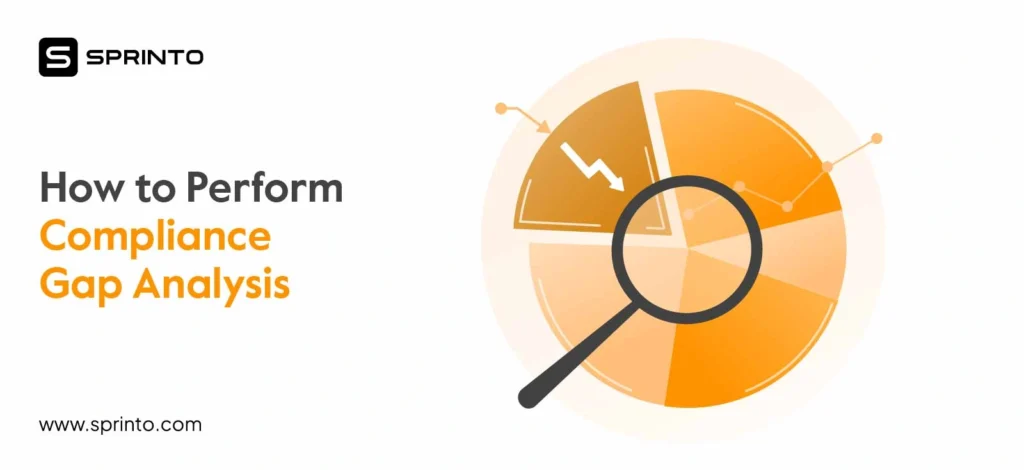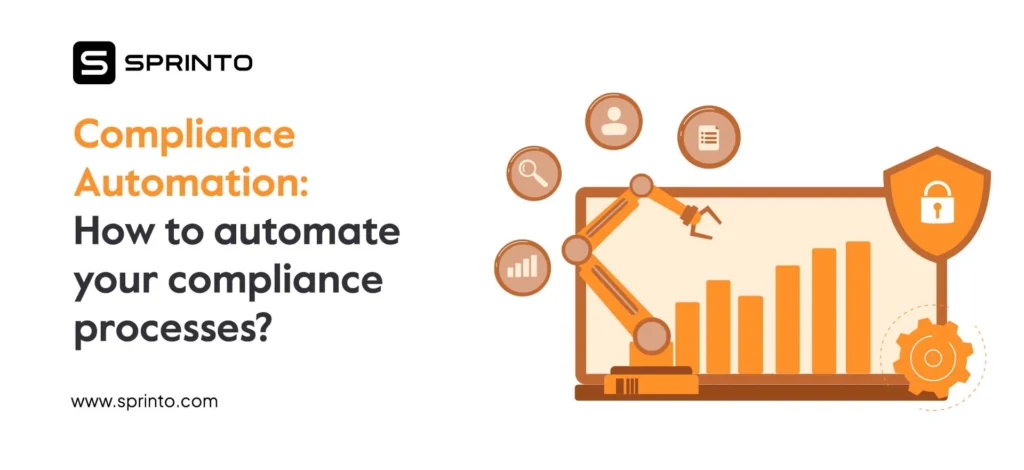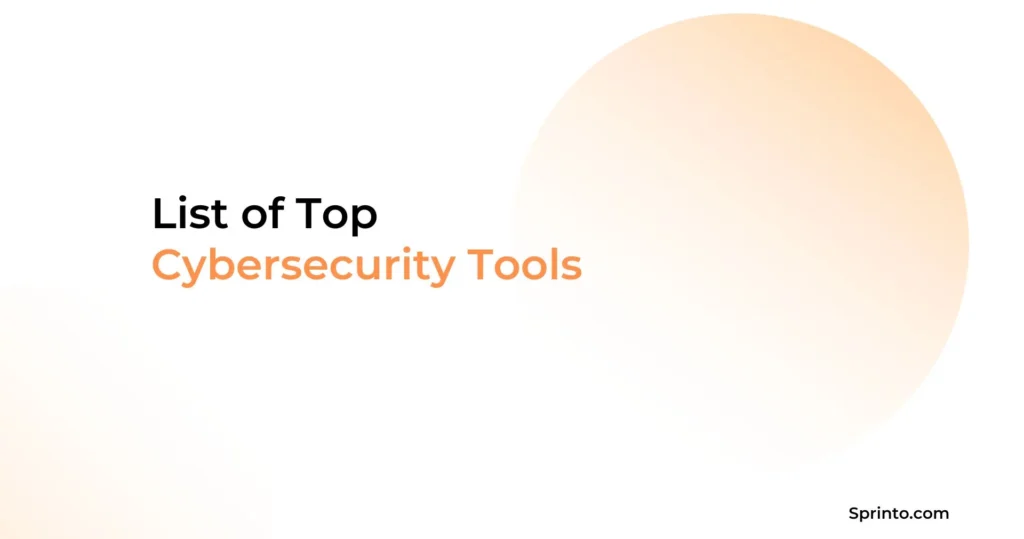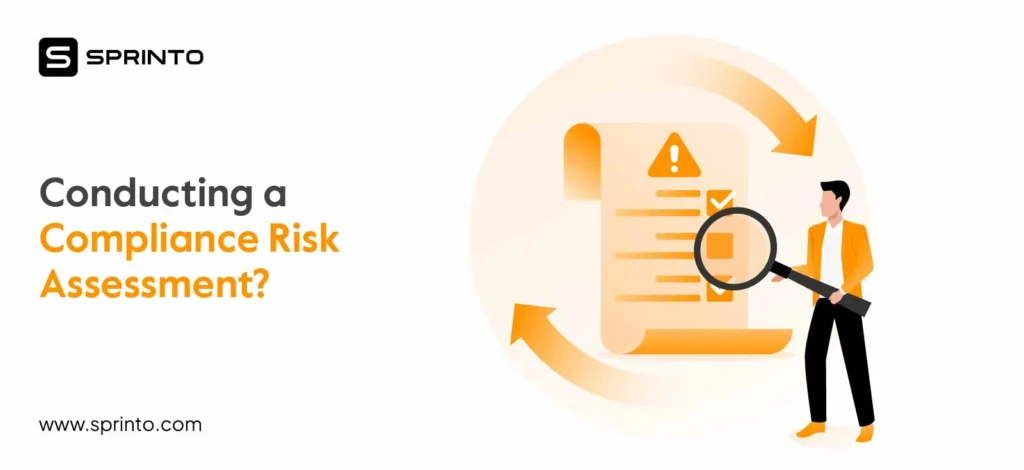Blink your eye, and a new AI model pops up, creating new benchmarks to follow.
That whirlwind pace is thrilling, but it only works if everyone can trust the AI you ship.
ISO 42001 lets you show, on paper and in practice, that your systems are safe, fair, and under control, without putting the brakes on innovation. Let’s familiarize ourselves with this powerful standard
| TL;DR ISO/IEC 42001:2023 is the first certifiable standard for managing AI, using the Plan-Do-Check-Act loop to keep systems ethical, secure, low-risk, and continuously improving. Implementation follows six stages: orientation and scoping, gap analysis, build policies, implementation and validation, certification audit, and continuous improvement. AI-specific requirements like bias testing, model explainability, human-oversight triggers, lifecycle traceability, and third-party model vetting protect fairness and accountability. |
What is an ISO 42001 checklist?
An ISO 42001 checklist is a structured document that itemizes every requirement and control in ISO/IEC 42001:2023 and pairs each with concrete tasks, owners, and evidence artifacts.
ISO/IEC 42001:2023 is the world’s first certifiable standard for an Artificial-Intelligence Management System (AIMS). It adapts the familiar “Plan-Do-Check-Act” cycle to AI and gives your organization a governance framework spanning ethics, risk, security, and continuous improvement.
With the global AI market set to grow at a 35.9% CAGR between 2025 and 2030, boards are demanding proof that innovation won’t outpace governance.
An ISO 42001 checklist translates the dense text of Clauses 4-10 and Annex A controls into actionable tasks, deadlines, and evidence requirements. It helps your teams track progress while giving auditors a clear map to verify conformity.
76% of compliance leaders plan to pursue an AI-specific certification within the next 18 months, and ISO 42001 tops their list. A well-maintained checklist becomes the pragmatic bridge between that strategic intent and day-to-day execution.
As Wael William Diab, chair of ISO/IEC JTC 1 SC 42, put it:
“ISO/IEC 42001 … will enable certification, increase consumer confidence in AI systems, and enable broad responsible adoption of AI.”
Download the ISO 42001 checklist
Key stages for using an ISO 42001 checklist
We have outlined six main stages for using an ISO 42001 checklist. These will help you move in a structured and organized manner in the ISO 42001 certification process:
Stage 1: Orient and scope
Your first job is orientation: purchase the ISO/IEC 42001 content itself and skim its high-level structure side by side with related AI standards, such as ISO 22989 (concepts) and ISO 23894 (risk). This will help you understand how the clauses fit together.
Next, identify the modules you build or operate. List the data sets, model families, and business units that will fall inside your Artificial-Intelligence Management System (AIMS).
Organizations that link this scoping memo to an executive sponsor move faster because budgets, risk appetite, and policy clashes get resolved in a single meeting. Modern GRC suites like Sprinto can embed that scope statement directly into an ISO 42001 control library.
Stage 2: Gap analysis and planning
With the scope in hand, run a structured self-assessment:
- Compare current controls to Annex A.
- Prioritise gaps by risk and regulatory exposure.
Translate the gaps into a funded roadmap. Rank tasks by inherent risk, regulatory exposure, and customer impact, then assign owners and deadlines.
Note
Treat this like a sprint backlog. Post each gap as a ticket so progress is visible.
Stage 3: Build the AIMS framework
Now you turn plans into policy. Draft or update documents covering data governance, model lifecycle, transparency, incident response, and supplier oversight, then log each one as objective evidence in your checklist.
Because ISO 42001 adopts the same High-Level Structure as ISO 27001, you can clone large sections of existing Information-Security Management System (ISMS) manuals, such as context and leadership, rather than starting from scratch.
Stage 4: Implement controls and validate
Implementation is where the checklist is put to work.
Automate as many controls as possible. Firms that integrate GRC automation report audit-prep cycles dropping from eight weeks to two because the evidence is gathered continuously rather than hunted down during the audit.
This is followed up with validation. Schedule an internal AIMS audit, document every non-conformity, and open corrective-action tickets in the same tracker the engineering team already uses. When auditors arrive, they should see a closed-loop system where issues are found, fixed, and re-tested rather than a static register of “known issues”.
Stage 5: Certification audit
Formal certification starts with a Stage 1 “documentation review”, so consolidate policies, risk assessments, training logs, and metric dashboards into a single, read-only repository and label each file by clause number. Reviewers love tidy evidence.
Stage 2 is the on-site (or virtual) audit. During this phase, assemble a dedicated audit team, share live Q&A updates in real time, and celebrate every success.
For example, Synthesia became the first AI video company to earn ISO 42001 certification in mid-2024 by putting together a clear, well-organized evidence pack and rehearsing every step so thoroughly that they sailed through with zero major non-conformities.
Stage 6: Continuous improvement
Build a one-page dashboard that tracks incidents, remedial cycle time, and open corrective actions, then review it in every management meeting; ISO 42001 Clause 9.3 demands that level of visibility.
As of this year, 90% of firms are already running an AI-compliance policy, so your board will expect those metrics anyway.
Finally, park a recurring calendar task to scan emerging regulations (the EU AI Act Explorer is a good free source), and patch your checklist when thresholds or definitions change.
AI-specific checklist items
Unlike “horizontal” management standards, ISO 42001 calls out several controls that only make sense when algorithms, data pipelines, and dynamic models are in play.
When you build or audit your checklist, make sure these boxes are ticked:
- Bias and Fairness testing (Annex A §A.5, A.7): Documents the metrics you will run and the threshold for acceptable spread across protected groups.
- Explainability by Design (A.8): Keeps artefacts such as model cards or capability statements that can be shared with users and regulators on request.
- Human-in-the-loop safeguards (A.9): Defines escalation triggers (confidence < X%, drift > Y% %) that hand decisions back to a qualified person.
- Lifecycle traceability (A.6): Versions every data set, training run, and hyperparameter set so you can reproduce a model that was shipped six months ago.
- Impact assessment records (A.5): Keeps a running log of intended use, foreseeable misuse, and mitigations for each AI asset; auditors will sample this file first.
- Data provenance and quality gates (A.7): Shows where data came from, how it was cleaned, and who approved each transformation step.
- Third-party model due diligence (A.10): Evidence that vendors were screened for security, privacy, and bias controls before their model was embedded.
- Incident-response guides for AI (Clause 8.6): A templated run-sheet for “model goes rogue” moments, including rollback steps and communication-wording.
Tools and resources you’ll use
The tools and resources we’ve picked will noticeably make the process of making your organization ISO 42001 compliant easier.
| Purpose | Tools and resources | Why they help |
| Governance cockpit | ISMS.online AIMS module, Sprinto, our ISO 42001 checklist | Pre-built control library and evidence mapping cut preparation time for audits. |
| Bias detection | AI Fairness 360 open-source toolkit | 70+ fairness metrics and 10 mitigation algorithms you can wire into your MLOps tests. |
| Model explainability | Google What-If Tool, Captum, SHAP dashboards | Probe a model without writing code and auto-generate feature sensitivity plots for your Annex A evidence pack. |
| Regulatory radar | EU AI Act tracker, NIST AI RMF 1.0, ISO/IEC TR 24027/24028 series | Map emerging laws and companion standards to Clause 4, “Context of the organisation.” \ |
| Audit readiness | Sprinto’s audit readiness checklist | Lets you rehearse Stage-1 questions before the certification body walks in. |
Useful tips to optimize your ISO 42001 checklist implementation
Follow these steps, and your ISO 42001 checklist turns into a trustworthy, high-velocity engine for AI.
- Treat it like DevOps, not paperwork
Build your checklist into the CI/CD pipeline: fail a build if bias metrics breach the threshold or if the model card isn’t regenerated. Organizations that “shift-left” controls cut audit findings by 32% year-over-year.
- Start with the riskiest model
Piloting on a high-impact use case (credit scoring, medical triage, etc.) forces the toughest conversations early and yields reusable artifacts for low-risk models later. KPMG notes that focusing on risk hotspots “fosters trust among stakeholders and facilitates the responsible use of AI.”
- Check overlap with existing ISO programs
If you already run ISO 27001 or 27701, map overlapping clauses (leadership, document control, internal audit) so you’re extending, not duplicating, controls. Highlights big overlaps that can shave months off the timeline.
- Automate evidence capture
Use pipeline hooks to push model artifacts, test results, and approvals straight into your GRC platform. In the 2025 Compliance Benchmark survey, audit prep time fell from 120 hours to 18 hours for teams that automated evidence.
- Embed a ‘red-team’ mindset
Schedule adversarial testing sprints where domain experts try to break or game the model; log findings as Annex A non-conformities and iterate. It keeps the checklist alive rather than shelfware.
- Gamify staff training
Run monthly five-minute quizzes on the AI policy and publish a leaderboard. Maybe you’ll see a jump in training completion after adding gift-card prizes because learning sticks when it’s fun.
- Document decisions
Every model change should carry a short “why” message linked to risk assessments and approval records. Auditors love seeing an immutable chain of custody for decisions.
- Rotate the checklist owners quarterly
Swapping the “checklist captain” spreads expertise and prevents blind spots. Pair each new captain with the outgoing one for a one-week overlap to maintain continuity.
- Adopt a ‘one-pager’ KPI dashboard
Track drift incidents, fairness scores, and time-to-mitigation on a single page reviewed at every management meeting. This satisfies Clause 9.3 management review and keeps C-suite eyes on real outcomes.
- Celebrate the audit; don’t dread it
Book a 30-minute debrief with auditors right after Stage 2 and share kudos publicly. Positive feedback turns into internal testimonials that sustain momentum for year-two surveillance audits.
How does Sprinto keep your ISO 42001 checklist alive?
Manual trackers work for the first week; then real life intrudes: models ship, datasets change, and “last-updated” cells go stale. The cure is to let a dedicated compliance platform shoulder the repetitive chores while your team focuses on building responsible AI.
One platform that has leaned hard into ISO 42001 is Sprinto. Let’s see how:
The moment you connect cloud, code-repo, HR and ticketing accounts, Sprinto auto-discovers every relevant asset and maps each clause of ISO 42001 to a testable control. It then starts pulling time-stamped evidence straight from source systems, a workflow the company says can cut “audit fatigue” by 90 %.
Because the collectors run continuously, you get 24×7 control monitoring. This “always-on” posture is the backbone of Sprinto’s promise to make compliance your default operating state.
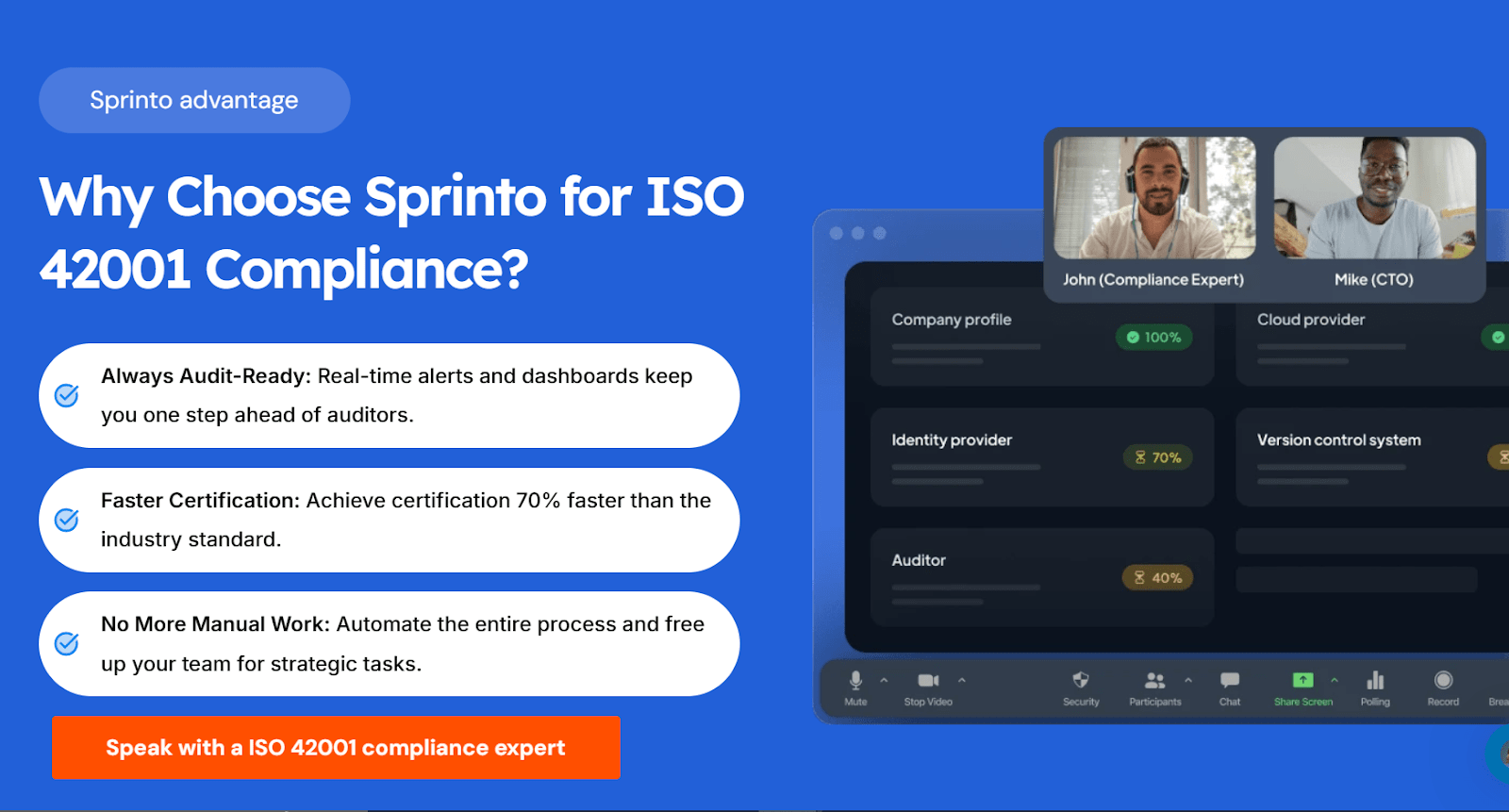
ISO 42001 ships with dozens of mandatory artifacts: policies, logs, training records. Sprinto’s pre-built templates and rule sets spin those up in hours, not weeks, and the vendor benchmarks a 10× speed-up over manual methods when you’re racing toward an external audit.
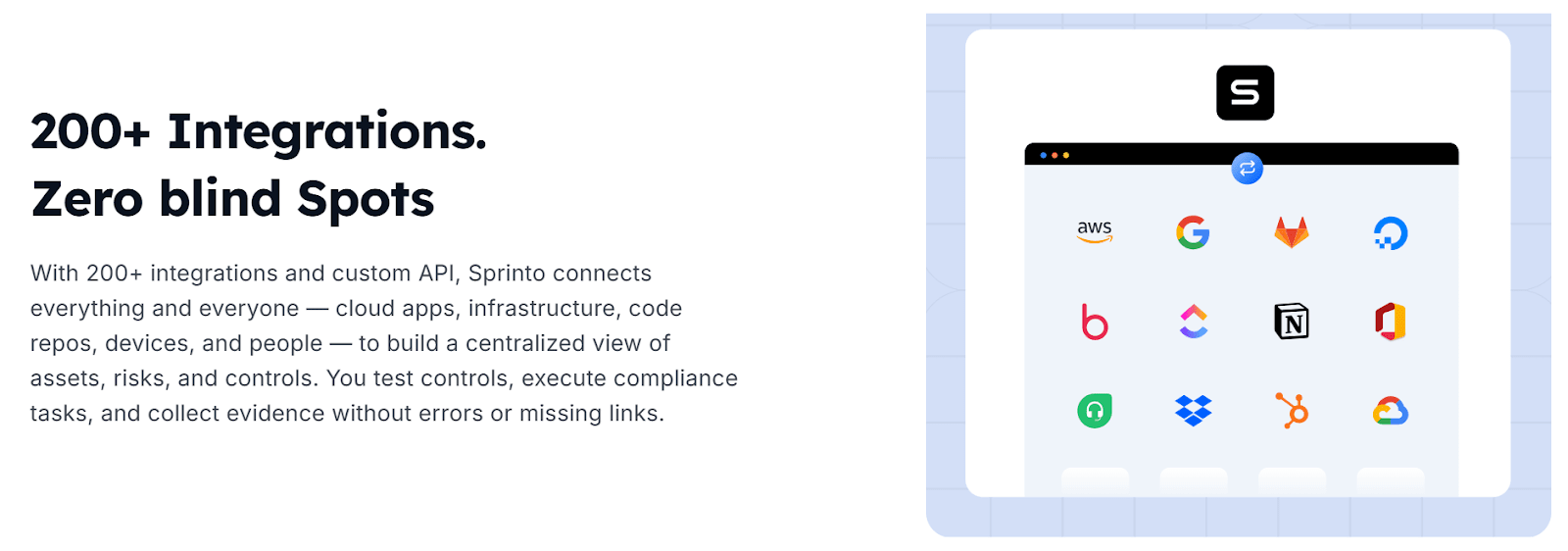
With 200+ native integrations and an open API, Sprinto plugs into AWS, Azure, GitHub, Jira, Okta, and most MLOps favorites, so even niche data pipelines stay in scope and under watch without custom scripts.
Frequently Asked Questions
1. What is included in an ISO 42001 checklist?
A good checklist covers every “shall” in the standard.
Expect items such as defining the AIMS scope, mapping stakeholders and legal obligations, risk-assessment and impact-assessment templates, data governance and bias-testing procedures, internal audit records, management review minutes, and evidence collection links.
It should be an inventory of all policies, controls, and proofs you must show an auditor.
2. How do I use the ISO 42001 checklist to prepare for an audit?
Start with a gap analysis: score each checklist item “met, partial, or missing,” then turn every gap into a ticket with an owner, deadline, and risk priority.
As you close tickets, attach live evidence directly to the matching checklist row. In the final weeks before the audit, run a mock review: walk through each item, rehearse answers, and confirm that every link opens the latest artefact.
3. How often should you update your ISO 42001 checklist?
Update it whenever you release a new model, onboard a major data source, change a policy, or when new regulations land; whichever comes first.
Many teams run a light review monthly and a deeper refresh each quarter; that cadence keeps evidence fresh and prevents sudden, big catch-ups right before surveillance audits.
4. Can a checklist ensure ISO 42001 certification?
A checklist is necessary but not sufficient. It keeps you organized, shows gaps early, and proves due diligence, yet certification still depends on having the controls truly implemented and passing an external auditor’s Stage 1 and Stage 2 reviews.
Pansy
Pansy is an ISC2 Certified in Cybersecurity content marketer with a background in Computer Science engineering. Lately, she has been exploring the world of marketing through the lens of GRC (Governance, risk & compliance) with Sprinto. When she’s not working, she’s either deeply engrossed in political fiction or honing her culinary skills. You may also find her sunbathing on a beach or hiking through a dense forest.
Explore more
research & insights curated to help you earn a seat at the table.










